Exploring Everyday Dinner Plates: Design and Culture
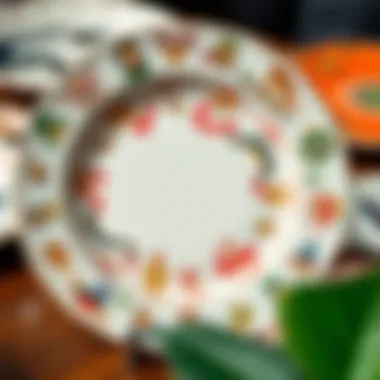
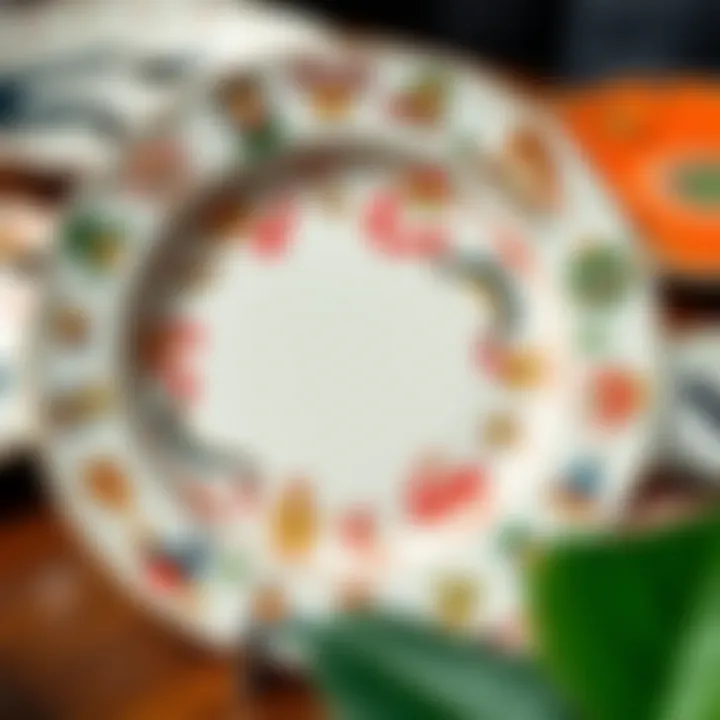
Intro
The dinner plate: a seemingly innocuous item found on almost every dining table yet one that carries immense historical and cultural weight. From simple ceramic designs to elaborate hand-painted styles, the journey of the dinner plate reflects the evolution of human society itself. Understanding its significance goes beyond the surface; it requires delving deep into the intricate relationships between design, functionality, and the cultural narratives woven into our dining experiences.
As we navigate this exploration, we’ll shed light on how dinner plates have morphed with changing tastes, innovations in material science, and societal values. Today, we’ll discuss various types of materials employed in their construction, the enduring influences of certain cultures on plate design, and how our everyday choices in these objects can speak volumes about our priorities regarding sustainability and aesthetics.
So, let’s dish out the details and unearth the stories these common yet complex artifacts have to tell.
The History of Dinner Plates
Understanding the history of dinner plates opens up a window into how societies have evolved in their dining practices, reflecting broader cultural nuances and technological advancements. From the simple earthenware used by ancient civilizations to the sophisticated designs that adorn modern tables, dinner plates are not just functional items; they are storytellers of a united culinary heritage. As we traverse through time and cultures, we’ll see how these plates have come to not only serve food but also to signify status, tradition, and artistic expression.
Origins of Tableware
The origins of tableware date back to times when humans began to gather for meals. In prehistoric eras, it was likely that simple bowls made from natural materials, like hollowed-out stones or shells, were used to hold food. As civilizations began to form, particularly in places like Mesopotamia and the Indus Valley, pottery became predominant. Early dinner plates were crudely shaped but functional; they were often made from clay and hardened through firing, resulting in items that could hold a variety of foods without leaking.
Furthermore, ancient Egyptians introduced a degree of artistry in their earthenware, decorating pots and dishes with intricate designs, often portraying deities or agricultural motifs. This creativity marked the inception of tableware as not just functional, but also as an expression of identity.
Evolution Across Cultures
As trade routes expanded, cultural influences blended, leading to a fascinating diversity in dinner plate designs. In China, for example, the invention of porcelain during the Tang Dynasty set a benchmark for quality and beauty in dinnerware. The delicate and durable nature of porcelain made it popular across the globe, influencing styles and production techniques in Europe.
Italian majolica and Spanish pottery also showcased bright colors and elaborate patterns. Each culture infused its unique flair into dinner plates. The introduction of the fine china in England during the 18th century revolutionized dining, emphasizing not only form but also function that appealed to the upper classes, creating a mark of prestige.
In contrast, traditional Japanese tableware, like the simplistic elegance of a zen-style dinner plate, illustrates a profound relationship between form and the philosophy of minimalism. The variety among dinnerware from different regions underscores how food presentation is shaped by local customs and artistic traditions.
Impact of Industrial Revolution
The Industrial Revolution was a game changer in the production of dinner plates. The shift from manual to machine production reduced the cost of manufacturing and increased availability. Brands like Spode and Wedgwood began to produce plates on a mass scale, making beautifully designed dinnerware accessible to the burgeoning middle class.
This period also introduced innovative materials, such as ironstone and transferware, which made dinner plates more durable and versatile for everyday use. Notable was the design of dinner plates that could withstand chips and breakage—this catered to households needing practicality without sacrificing style.
Consequently, the Industrial Revolution laid the groundwork for a dining experience that emphasized both social gatherings and culinary arts, setting a stage for modern-day dining conventions.
In summary, the history of dinner plates serves as a reflection of societal norms, artistry, and technological progression in human culture. Understanding these origins enriches one’s appreciation of these fundamental yet often overlooked aspects of our dining experiences.
Materials Used in Dinner Plates
Considering the materials used in dinner plates is vital to understanding their functionality and design. These choices directly influence everything from the visual appeal of a table setting to the durability and practicality of the plates themselves. For interior designers, homeowners, and decorators, selecting the right material is not merely about aesthetics but also about aligning with the values of sustainability and lifestyle preferences.
Ceramics and Porcelain
Ceramics and porcelain are among the most common materials found in dinner plates, revered for their beauty and resilience. Ceramics, made from clay and various minerals, can be refined into a diverse array of textures and finishes. Porcelain, a subtype of ceramics, is known for its translucence and exceptional strength, making it an heirloom-worthy choice for those who cherish intricate designs or delicate patterns.
The rich history of ceramics can be traced back thousands of years, with cultures worldwide adapting the material to their dining customs. For the modern table, these plates present itself in numerous styles—from rustic artisanal pieces to sleek contemporary designs. This versatility means they can seamlessly integrate into any dining room, whether you're hosting a formal dinner party or a casual family meal.
While many enjoy the aesthetic appeal of these materials, it is crucial to note some considerations. Porcelain dishes, for instance, can chip if mishandled, and not all ceramics are dishwasher safe. So, knowing about care instructions and limitations can help in selecting the right plates that match your lifestyle.
Glass Dinnerware
Glass dinnerware has made a significant impact, not only in terms of its sleek, modern look but also due to its practicality. With options ranging from tempered glass, which offers greater durability to colored glass that adds a splash of personality to your table, glass plates can elevate any dining experience without overwhelming it.
In addition to their aesthetic appeal, glass plates are generally easy to clean and often microwave safe. However, they can be heavier and more fragile than other materials, which means careful handling is key. Using glass as a dinnerware option can create a feeling of elegance, as light can pass through and reflect beautifully on the surface.
"Glass dinnerware lends an air of sophistication to everyday meals while allowing the vibrant colors of your culinary creations to shine!"
Melamine and Its Applications
Melamine dinnerware has gained favor, especially among those seeking practical yet stylish solutions. Known for its longevity, melamine plates are virtually indestructible, making them a popular choice for outdoor dining and family gatherings where clumsiness might strike. Further, innovation has led to a broad range of designs that can mimic more expensive materials, allowing for a more refined look without the hefty price tag.
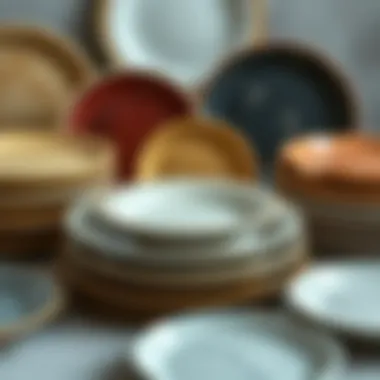

However, it's essential to keep in mind that while melamine is durable, it shouldn't be used in microwaves, as high temperatures can alter its structure. Knowing the intended use of melamine can help one appreciate its full potential without compromising safety.
Sustainable Materials
Sustainability in dinnerware materials has become increasingly significant, reflecting a societal shift toward eco-consciousness. Options like bamboo or recycled materials are now accessible, appealing to both the environmentally minded consumer and the interior design community seeking to make responsible choices.
Bamboo plates, for instance, are biodegradable, compostable, and lightweight, making them a great choice for casual dining. Brands that focus on sustainability often incorporate reclaimed materials into their designs, adding a unique character to each piece. Yet, it’s crucial to verify the sourcing and manufacturing processes to ensure that sustainability claims are backed by authentic practices.
When choosing dinnerware, thinking about how materials affect both aesthetics and the environment turns purchasing into a meaningful decision. Familiarizing oneself with the qualities and applications of various materials is vital to making an informed purchase that reflects personal values and enhances the dining experience.
Design Trends in Dinnerware
In recent years, dinnerware has transcended its functional role, morphing into a canvas for artistic expression and a reflection of personal style. In the realm of design, the evolution of dinner plates has become synonymous with broader aesthetic movements, challenging traditional concepts while focusing on user preference and dining experience. The importance of understanding design trends in dinnerware lies not just in aesthetics but also in how these designs impact dining atmospheres and enhance culinary presentation. This aspect is particularly relevant for interior designers, homeowners, decorators, and stylists who aim to curate spaces that resonate with cultural narratives and contemporary lifestyles.
Minimalism vs. Maximalism
Minimalism and maximalism encapsulate the very essence of modern dinnerware design. Minimalism emphasizes simplicity, reflecting the age-old adage, "less is more." Plates in this category often feature clean lines and muted colors, creating an understated elegance that aligns seamlessly with various interior styles. Consider a white porcelain plate, its surface smooth and unmarred, allowing the food to take center stage without distraction.
In stark contrast, maximalism boasts color, texture, and exuberance. Think of vibrant, patterned plates that seem to weave stories of cultural richness. This design language invites boldness into dining experiences, often sparking conversation. For instance, a dinner plate adorned with intricate folk art can transport diners to a celebration of heritage, enriching meals with an appreciation of cultural narratives.
"In a world full of trends, I want to remain a classic." – Iman
Color and Texture Innovations
The sophistication of color and texture in dinner plates has seen reinvention over the past few years, influenced heavily by trends in other design spheres. Plates now often feature gradients or ombre effects, which not only catch the eye but also create a playful juxtaposition against various food textures. Textural innovations such as matte finishes, raised patterns, or personalized glazing further enhance the tactile experience of dining. Fun fact: the tactile realm is where color and design can play off each other to produce a complete sensory journey, one that expands beyond mere taste. For example, a rough, textured surface can offer an organic feel, whilst glossy finishes can evoke a sense of modern chic.
Handcrafted vs. Mass Produced
Handcrafted dinner plates are celebrated for their character and uniqueness. Each piece tells a story, often imbued with the creator's personal touch, ensuring that no two plates are entirely alike. This artisanal approach often appeals to those seeking authenticity and sustainability, as many handcrafted dinnerware options prioritize eco-friendly practices and materials. On the flip side, mass-produced dinner plates bring accessibility to the design realm. They cater to functionality while still flaunting trend-aware aesthetics. A juxtaposed dynamic exists here; where handcrafted plates might elevate a dining experience through individuality and character, mass-produced dinnerware excels in uniformity and ease of replacement.
Ultimately, understanding these design trends not only empowers consumers in their choices but also enriches their overall dining experiences. As dinnerware transitions into a multifaceted entity, it embodies not just functionality but also artistry, cultural significance, and personal expression.
Cultural Significance of Dinner Plates
Understanding the cultural significance of dinner plates offers a unique perspective into how food presentation and dining rituals can reflect societal norms, values, and even historical contexts. Dinner plates are not just functional items; they embody cultural stories and convey messages about identity, tradition, and social interaction. This section explores the intricate interplay between dinner plates and cultural practices, revealing how they have evolved to delineate culinary traditions, enhance festivities, and underscore social hierarchy.
Culinary Traditions Around the World
Dinner plates often reflect the diverse culinary traditions that exist in various cultures. For instance, in Japan, the use of ceramic ‘yakimono’ plates is deeply intertwined with the aesthetics of ‘kaiseki’ dining, where the presentation of food is as significant as its flavors. Each plate has a purpose, serving specific dishes in meticulously crafted arrangements that enhance the dining experience. Similarly, in Mexican culture, the vibrant designs of Talavera pottery capture the essence of its regional flavors, bringing a vivid, artistic touch to each meal.
The choice of plate material also holds cultural importance. In Italy, for instance, you might find rustic wooden plates used for serving antipasti, embodying a rustic charm that complements the country’s culinary heritage. Each culture tailors its dinnerware not just to function but to resonate with its unique culinary expressions, creating an intimate bond between the eater and the food.
Dinner Plates in Festivities
Dinner plates often take on specialized meanings during cultural festivities. Major holidays or celebrations, such as Thanksgiving in the United States, see families bringing out heirloom china that may symbolize familial bonds and shared history. The characteristics of the dinner plates used often relate to the cultural or religious significance of the festival itself. For example, during Diwali in India, colorful, ornate plates might be adorned with sweets and savory treats, representing prosperity and joy.
Seasonal motifs are another significant aspect; plates with autumn leaves come out in the fall, while ones decorated with winter scenes might appear in December. These seasonal adaptations highlight how dining etiquette can shift according to the calendar, reinforcing cultural traditions while fostering connections among family and friends.
Signifiers of Class and Status
Dinner plates are also powerful signifiers of class and status, often reflecting socio-economic disparities in society. High-end dinnerware brands like Royal Copenhagen or Wedgewood are not only sought after for their beauty but also for what they represent. Owning such pieces can signal affluence and taste, sometimes turning a simple meal into a showcase of wealth.
Luxury dinnerware is typically associated with formal dining, while more affordable options may be favored for everyday use. This difference in dining experiences can lead to perceptions of exclusivity, where certain dishes are only served on more elaborate table settings, thereby elevating them in status.
In many cultures, the choice of dinner plate material and design reflects not just personal taste but deeply entrenched social structures. This dynamic continues to evolve, revealing the ongoing interplay between dining customs and societal expectations. Ultimately, dinner plates serve as more than mere vessels for food; they encapsulate cultural heritage, festive joy, and social stratification, making them pivotal in understanding our shared human experience.
Functional Aspects of Dinner Plates
When thinking about dinner plates, many people might just see a flat surface for food. However, this mundane item carries with it plenty of functional aspects that greatly enhance our dining experiences. Let's dive deeper into this side of dinner plates, exploring their essential roles that go well beyond mere decoration.

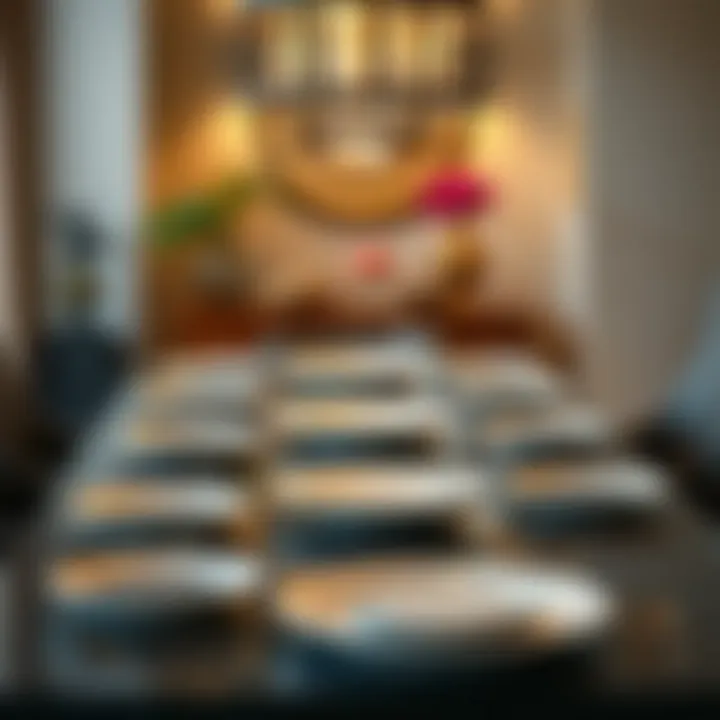
Size and Shape Considerations
Selecting the right size and shape of a dinner plate is more than an aesthetic choice; it's about comfort and practicality during meal times.
- Size: Plates typically come in various diameters, and choosing one isn’t merely a matter of personal style. Smaller plates can create the illusion of larger portions, which can be particularly useful in entertaining to manage food presentation or when serving courses in a formal dinner setup. On the other hand, oversized plates can make the meal seem sparse, losing the appeal of abundance. It’s important to consider the type of meal being served as well. A hearty dish may benefit from a larger plate, while delicate entrees might shine better on smaller dishes.
- Shape: Round plates are timeless and often used for everyday meals, but think beyond the circle and consider square or rectangular options. These shapes can change the way food looks and can be particularly effective for plating, making each item distinct. Something like a vibrant salad or an eye-popping entrée can stand out better on a less traditional shape.
"Choosing the correct size and shape of your dinner plate can elevate not just the dish presented, but the dining experience overall."
The Role of Dinner Plates in Service Styles
Dinner plates also greatly influence service styles at dining tables, whether it’s a casual family meal or a formal event. Different styles bring unique aspects to the dining experience.
- Individual Service: Plates commonly serve individual portions, promoting a neat arrangement and making it easier for guests to eat. This is particularly useful during casual gatherings where food is served buffet-style. Each guest can select the items they prefer and manage their portions easily.
- Family Style: In family-style dining, larger plates are made available to share among guests. The focus here shifts to collaborative dining experiences. This can create a sense of togetherness that might otherwise be lost with individual servings. It's a more organic way to share dishware, as people access what they want rather than adhering to strict serving sizes.
- Plated Service: This is usually seen in higher-end gatherings. Here, each dish is carefully plated by the chef and served on porcelain plates. This style emphasizes hospitality, where presentation meets precision. It allows chefs to showcase their culinary artistry, making the meal appealing at multiple levels.
Maintenance and Care Requirements
Finally, the longevity and upkeep of dinner plates shouldn't be overlooked. Different materials and finishes have unique care needs, and being aware can help enhance the life span of your dishware.
- Ceramic and Porcelain: These tend to be durable but require gentle handling. Dishwashing is often seen as quick, but handwashing is preferred for higher-end porcelain to prevent chipping and to maintain their shine.
- Glass Dinnerware: Though attractive and versatile, glass requires special care during cleaning. Avoid abrupt temperature changes to prevent shattering and inspect regularly for scratches.
- Sustainable Materials: With sustainability trends on the rise, dishes made from bamboo or recycled materials often require specific cleaning methods to remain in good condition. Generally, these aren't microwave-safe, and understanding this is vital for proper maintenance.
In summary, the functional aspects of dinner plates encompass crucial elements like size and shape considerations, roles in service styles, and specific maintenance needs. Each factor contributes to a well-rounded understanding of how plates play a pivotal role in dining.
Continuing to recognize and appreciate these elements can enhance not just the enjoyment of our meals, but also the connection we feel during those shared experiences.
Selecting the Right Dinner Plates
Choosing the right dinner plates is not just a matter of aesthetics; it directly affects the dining experience. The dinner plate—the canvas for your culinary creations—serves multiple purposes beyond merely holding food. In the modern world, where dining often interlaces with social interaction and cultural expression, the right dinner plates can enhance both the meal and the gathering.
When selecting dinner plates, consider how they align with your culinary style, entertaining habits, and the overall vibe of your home. Are you a home chef who enjoys plating gourmet meals? Or perhaps you're looking for something versatile for family dinners and casual get-togethers? Understanding these nuances can lead you to make an informed decision.
Considering Your Dining Experience
A plate is more than just something you serve food on; it shapes the dining experience. Think about the type of meals you usually prepare or enjoy. If your culinary repertoire features rich, saucy dishes, a plate with a wider rim can help contain those delightful juices without making a mess of your table. Conversely, if you often serve tapas-style dishes, smaller plates can enhance sharing and create a more dynamic dining atmosphere.
Here are some key elements to ponder:
- Size: Standard dinner plates generally measure about 10 to 12 inches in diameter, but larger plates may be suitable for meals with multiple components.
- Shape: Round plates are classic, while square or oval-shaped plates can add a modern touch.
- Depth: Plates with a slight lip may help prevent spillage, especially for soups or stews.
Think about the ambiance and the occasion as well. Are these plates for casual living or formal dining? Differentiating between those will guide your selection toward practical versus polished options.
Budgeting for Quality Dinnerware
Quality matters in dinnerware. Investing in the right plates can elevate mundane meals into special occasions. But how do you gauge quality without breaking the bank? Here are some pointers:
- Material Consideration: Higher quality materials like porcelain or bone china tend to be more durable and resistant to chipping. They also retain heat better, which is a plus for serving hot meals.
- Brand Reputation: Products from established brands such as Noritake or Royal Doulton often combine tradition with modern designs, assuring you of quality.
- Lifestyle Fit: If you lead a hectic lifestyle or have children, durable materials such as melamine may be more practical, albeit with slightly lower perceived elegance.
Budgeting is pivotal; it helps balance between cost and quality. Looking for plates that offer both functionality and beauty within your budget can lead to fulfilling choices that serve you for years.
Guidelines for Mixing and Matching
Who said dinner plates had to match? Mixing and matching can infuse personality into your dining setup while highlighting individual pieces. Rather than getting all your dinnerware from a single set, creating a unique collection can invite conversation. Here are some handy guidelines:
- Color Cohesion: Choose a common color palette to create harmony. Neutrals mixed with bright colors often work well, providing a delightful visual contrast.
- Varying Textures: Combine pieces with different finishes, such as matte plates with glossy accents, to create an interesting table surface.
- Similarly Styled Patterns: Even if the designs are different, aligning within the same thematic style—like floral or geometric—can unify your table settings.
Exploring different combinations not only allows personal expression but also lends an artistic air to your dining experience. You may find that a little creativity here can turn an everyday dinner into an extraordinary affair.
Dinner Plates in the Age of Social Media
In a world where a glance at a screen dictates trends and tastes, dinner plates aren't just items of functionality anymore; they are canvases of expression and identity. Social media platforms, particularly Instagram, have transformed the mundane act of dining into a showcase of style and creativity. People are no longer simply eating off dishes; they are curating experiences that can be captured, filtered, and shared.
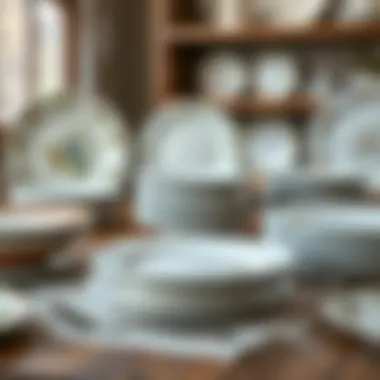
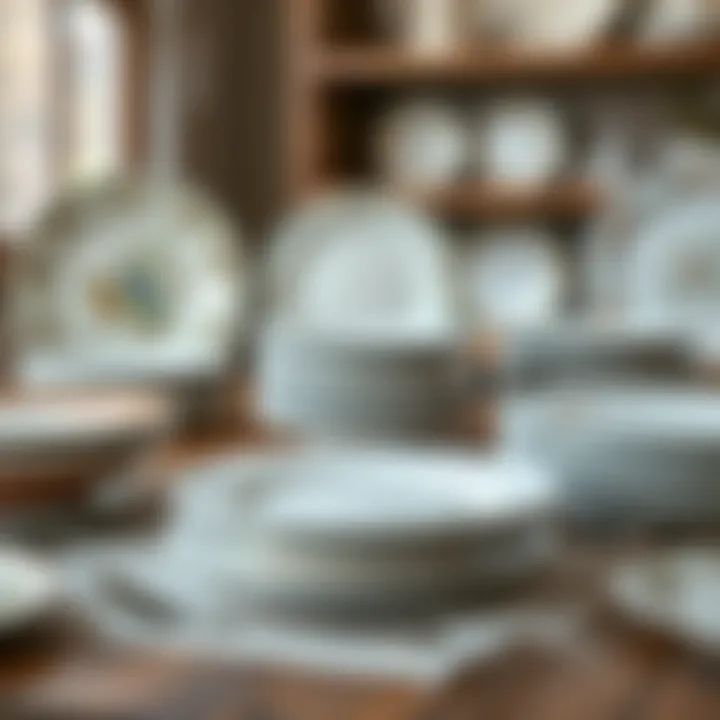
The significance of dinner plates in this era can't be overstated. They serve as the backdrop for memorable moments, highlighting not just food but the overall dining experience. For interior designers, homeowners, and stylists, understanding how social media influences dinnerware choice can be pivotal in creating environments that resonate in both taste and aesthetics.
Influence of Instagram on Dinnerware Choices
Instagram, with its visual-centric interface, has become the unofficial curator of dining aesthetics. The platform encourages users to share images of their meals, thus elevating the importance of the dinner plate from functional to a focal point of beauty. A plate that's "Instagrammable" often carries qualities such as unique patterns, vibrant colors, and distinct shapes.
Food bloggers and influencers have stepped into the role of tastemakers, promoting specific brands or styles simply through their choice of dinnerware. This can create a ripple effect—one influential post can push a certain dinner plate design into mainstream popularity overnight. Many diners are now influenced not just by practicality but by the want to present an attractive tableau that garners likes and engagement. Therefore, social media can radically shift diner expectations, compelling manufacturers to rethink their designs to entice the eye of the online audience.
The Rise of Table Setting Aesthetics
A well-set table is increasingly seen as an art form rather than a mere setup for meals. Beautifully arranged plates, carefully chosen cutlery, and striking centerpieces are all integral parts of a dining experience that social media amplifies.
The aesthetic of table settings has transcended cultural boundaries, encouraging a blending of styles and influences. From rustic farmhouse vibes to sleek modern minimalism, the variety of table setting aesthetics reflects personal taste and social trends, while also fostering conversations about beauty and creativity in dining.
As such, designers and homeowners should consider how the organizational layout of dining tables can influence guests' experiences and perceptions. A well-composed setting may inspire not only an appreciation for the food but for the thoughtfulness behind the overall presentation.
User-generated Content and Trends
User-generated content heralds a shift in how products are marketed and perceived. Reviews accompanied by engaging visuals provide an organic touch that traditional advertising often lacks. Potential buyers find a sense of authenticity in those images shared by fellow users, which makes them inclined to purchase similar dinner plates that contribute to their aesthetic desires.
This phenomenon leads to a cycle of feedback where users, inspired by others, are eager to showcase their own dining setups. Elements like new dinnerware trends, seasonal colors, or themed dinner parties often go viral, proving how interconnected communities are through shared dining experiences.
Moreover, user-generated content captures a wide array of perspectives and styles, reflecting the diverse culinary backgrounds and personal preferences of individuals around the globe. Such insights can help homeowners make informed choices about what dinnerware aligns with their sense of style and the atmospheres they wish to create at home.
"In the age of social media, the dinner plate is not only a dish but also an invitation to showcase creativity and personalization in dining."
As discussions about dinnerware proliferate in the digital landscape, it becomes clear that dinner plates are more than vessels for food; they are statements of identity influenced by cultural dynamics and modern technology.
Future Trends in Dinner Plate Design
In a world where innovation is the name of the game, dinner plate design has not been left behind. The way we think about plates today is rapidly changing, much like fashion on the runway. What's brewing in the trend pot? Quite a bit. Let’s unpack the advancements shaping how dinner plates not only look but also function.
Technological Innovations in Manufacturing
Manufacturing techniques have taken a leap into the future, giving birth to smarter dinner plates. 3D printing is perhaps the most notable of these innovations. This technique allows designers to craft unique shapes and complex designs that traditional methods simply can't replicate. Imagine a dinner plate with intricate patterns woven into its very structure, all thanks to a printer and some clever software. The ability to produce small batches of custom plates means that the artistry is returning to dinnerware, moving away from the impersonal, mass-produced styles.
Another major player is automation in production. With machines doing a lot of the heavy lifting, manufacturers can keep up with rising demand while maintaining quality. However, it does raise a question: at what point does the charm of handcrafted plates vanish? It’s a balancing act between efficiency and uniqueness, a tug-of-war that continues to unfold in the manufacturing realm.
Sustainability as a Key Focus
Sustainability is not just a buzzword; it is becoming a principle focus in dinner plate design and manufacturing. As societies grow increasingly aware of their environmental footprint, the demand for eco-friendly materials is skyrocketing. Gone are the days when convenience was chosen over sustainability. Consumers now seek plates made of biodegradable materials, like bamboo or recycled glass, driving manufacturers to rethink their offerings.
This shift isn’t just about material types; it extends to the entire lifecycle of a product. For instance, some companies are exploring minimalistic designs that require less material usage without sacrificing durability. Utilizing local resources during production reduces transportation emissions, further enhancing the eco-friendliness of these dinner plates. Each mindful choice in the design process reflects a collective responsibility toward our planet. The culinary world is slowly aligning its creativity with sustainability, ensuring that the future is not only aesthetically pleasing but also ethically sound.
Personalization and Customization Trends
Personalization is creeping into every corner of our lives, including our dinner plates. Imagine a scenario where each plate on your dining table is uniquely yours - that’s not far off. Consumers are increasingly looking for ways to express individuality through their tableware. Brands now offer customizable options, where people can choose colors, patterns, or even engrave names or meaningful quotes onto their plates.
Customization isn’t just about looks; it also extends to functionality. Some plates now come with modular designs, allowing users to mix and match segments or attach different sections for a more dynamic dining experience. By catering to personal tastes, manufacturers not only create a deeper emotional connection but also transform dining into a more personal affair.
"Dinner plates are evolving from mere tools of function into an expression of identity and conscience."
Closure
In wrapping up this extensive exploration of dinner plates, it's critical to underscore the significant role these seemingly ordinary items play within our dining experiences and beyond. Dinner plates are more than just vessels for food; they embody cultural narratives, reflect personal aesthetics, and facilitate social interactions.
Summary of Key Insights
Throughout the discussion, several key insights have emerged:
- Cultural Reflection: Dinner plates are a canvas upon which stories of tradition, family, and celebration are painted. Different cultures employ various designs, materials, and sizes that complement their unique culinary practices.
- Design Functionality: The evolution of dinner plates showcases a delicate balance between aesthetic appeal and practical use. Current trends stress simplicity and sustainability, influencing everything from the shapes we choose to the materials utilized.
- Social Media Influence: In an age where presentation can be as important as flavor, social media has transformed how dinnerware is perceived. Plates must now not just serve food but serve as objects of admiration, shaping consumer choices vastly.
- Innovation: Technological advancements have led to the creation of new materials and methodologies in plate production, offering both durability and sustainability.
Final Thoughts on the Importance of Dinner Plates
The dinner plate, often overlooked amid the hustle of daily life, carries substantial weight as a tool of not just dining, but of communication, tradition, and expression. Every dish served demands a thoughtful backdrop, and the choice of plate can enhance or deter from this experience. Interior designers, homeowners, and decorators must recognize that choosing the right dinnerware is an opportunity to express individual taste and cultural identity. As the trends continue to evolve with sustainability at the forefront, diners are encouraged to choose plates that reflect their values while stimulating their culinary creativity. Ultimately, the humble dinner plate serves as a pivotal piece in the grand tapestry of our dining rituals, deserving of appreciation and thoughtful selection.
"What’s on your plate often reflects what’s in your heart."
In recognizing the true significance of dinner plates, we're reminded that while food nourishes our bodies, the way we present it nourishes our souls.



